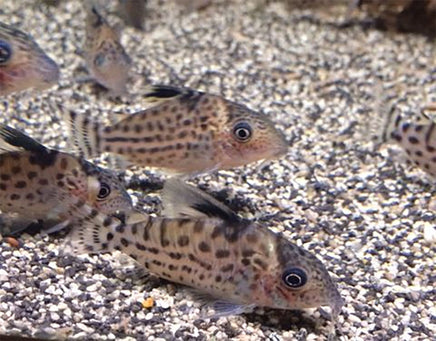
Agassizi Cory Catfish
Typical Cory in shape and one of the many spotted Corys, with pale base colour and darker spotting on the body. The Agassizii's spots should be of good size and fairly round, from the caudal peduncle to the gill plates. There should be some spotting in the otherwise-translucent caudal fin. The dorsal fin should be tall with the first spine being darker in colour to the back of the fish. The head should be smoky-grey in colour with a pale belly.
Sexing - When properly conditioned, the difference between the male and female Corydoras is usually quite evident. Females will look a lot wider when viewed from the top, as they have a larger underbelly. Males are also shorter in length than females.
Tank Companions - Very peaceful community fish. Will not intentionally bother tank inhabitants, however their bumbling about the tank may bother more delicate fish or other bottom dwellers. Are best kept in groups of 5-6 or more.
Other Parameters - Requires a sand or small gravel substrate and prefers a planted tank. Keeping a cory on sharp or large gravel can lead to damage to their barbels, which when infected will make it hard for the cory to find food.
Corys are sensitive to salt, as with other scaleless fish, adding salt to the tank will cause them harm.
Feeding - As with most Corydoras, these fish will eat most food which sinks to the bottom of the tank. Sinking algae pellets should be supplemented with flake food or other sinking foods like catfish pellets.
Be aware these fish do have a carnivorous side to them and love foods such as Bloodworm and Brine Shrimp. Vegetable-based foods offer little nutrition to them. They will also eat any dead, dying, or even injured fish, that sit on te substrate too long. They're very opportunistic! These fish are most active at night, so feeding once before lights out is typically enough. Though they can easily be persuaded to feed during the day. Since they are slower eaters they should be allowed at least 30 minutes to consume their food.
